 Here’s an image as flat-out bizarre as any you’re likely to see: the head of a woman floating in midair, bodiless but for a bloody spine, at the end of which dangles a clump of living organs (lungs, heart, intestines, etc.). I think it’s fair to say you’ll never see anything like this in an American horror movie, but critters like the one I just described have turned up in many South Asian exploitation films. Indeed, floating head movies were quite common in Indonesia and Thailand during the seventies and eighties (with titles like KRASUE SAO, STREET RACING GRASUEH, KRASUE GAD POP, ITTIRITH NUM MUN PRAJ, TAYARD KRASUE SAWASS, etc), although most of them now appear to be lost.
Here’s an image as flat-out bizarre as any you’re likely to see: the head of a woman floating in midair, bodiless but for a bloody spine, at the end of which dangles a clump of living organs (lungs, heart, intestines, etc.). I think it’s fair to say you’ll never see anything like this in an American horror movie, but critters like the one I just described have turned up in many South Asian exploitation films. Indeed, floating head movies were quite common in Indonesia and Thailand during the seventies and eighties (with titles like KRASUE SAO, STREET RACING GRASUEH, KRASUE GAD POP, ITTIRITH NUM MUN PRAJ, TAYARD KRASUE SAWASS, etc), although most of them now appear to be lost.
Perhaps even more unbelievable, to Westerners at least, is the fact that the “witch with flying head” featured in those films is a staple of Asian folklore that figures in the mythologies of several different cultures. In Indonesia the critter is known as a Leak, in Malaysia a Penanggalan (meaning “Head with Dancing Intestines”), a Krasue in Thailand and an Arb in Cambodia. (There’s also the somewhat similar but less interesting Manananggal from the Philippines, which sprouts wings that cause the upper torso to detach from the rest of the body; it’s depicted in films like 1989’s IMPAKTITA and two episodes of the SHAKE, RATTLE & ROLL anthology series).
The creatures’ exploits tend to vary from culture to culture, but for the most part they’re believed to travel by night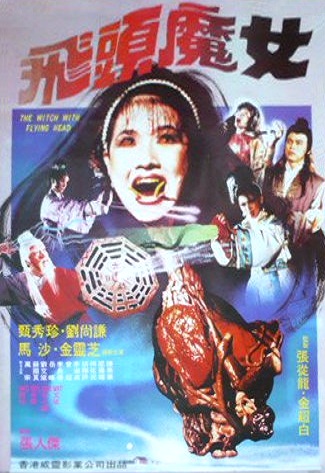 and drink blood, especially that of newborn children. I understand that in many South East Asian countries superstitious residents arrange sharp objects around their windows, so the monster’s innards will get stuck should it try and enter during the night.
and drink blood, especially that of newborn children. I understand that in many South East Asian countries superstitious residents arrange sharp objects around their windows, so the monster’s innards will get stuck should it try and enter during the night.
It shouldn’t come as any surprise that Leaks, Penanggalans, Krasues and Arbs regularly turn up in South Asian movies. The six films outlined below represent a small sampling of the floating head film cycle (which apparently numbers in the dozens), being among the few that are still extent. The classics, I’m sorry to report, are slim to nonexistent, but viewers desiring something out of the ordinary will be sated.
The Hong Kong period extravaganza WITCH WITH FLYING HEAD (FEI TAUGH ME NEUIH ) is the earliest film on this list, with a copyright date of 1977 (although the film would actually appear to hail from the late sixties, as evinced by the fact that cast member Peter Chen Ho died in 1970). The title essentially tells the story, as a woman living in some unspecified feudal time is invaded by a malevolent serpent who slithers up her vagina, where it stays for some time (we get periodic close ups of the snake inside her body) and causes her to become a bodiless blood-drinker each night. In this way director Lian Sing Woo combines mythological motifs with the invasive serpents popular in many Hong Kong films of the time (see CALAMITY OF SNAKES, KILLER SNAKES, LEWD LIZARD, etc.).
Of course the flying witch of this film can do other cool things like shoot lasers from her mouth and breathe fire. But there’s a cult of magical snake people afoot in the town, many of whom want the witch’s head (pun intended), leading to a final FX showdown of near-indescribable insanity. There’s also the requisite eel barfing and martial arts action we’ve come to expect from HK horror flicks, not to mention quite a few music cues blatantly lifted from other movies. The special effects are fairly impressive considering the tawdriness of the production—note the way the title character’s dangling entrails pulsate—and there are some genuinely chilling moments, especially toward the end. Overall, though, the effect is one of over-the-top hilarity.
(Digressing a bit, I feel compelled to address a like-minded film listed on the IMDB: PENANGGALAN, an alleged 1967 Hong Kong/Indonesian/Malaysian production directe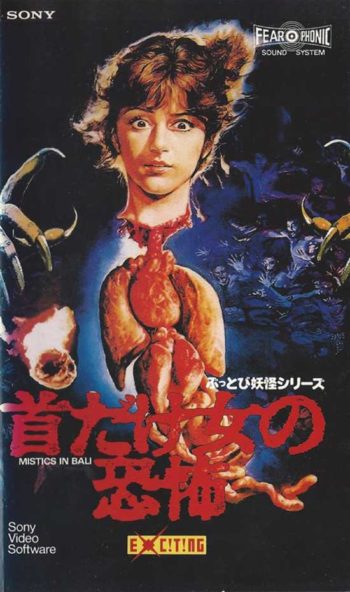 d by Tulsi Ramsay, of India’s famed Ramsay family, and featuring the Indonesian starlet Suzzanna. It was apparently also “banned for forty years in Malaysia and Australia.” Sounds tantalizing, but careful research reveals this film is either an outright hoax or a mislabeling—possibly of WITCH WITH FLYING HEAD, which as stated above is believed to have emerged from the late sixties. Consider: none of the Ramsays have ever made movies outside India, and they didn’t begin making horror films until the early seventies. Furthermore, PENANGGALAN doesn’t appear in any reference volume that I’ve been able to locate. Its existence as far as I can tell begins and ends with the IMDB, whose listing comes complete with a user comment that’s clearly describing an entirely different film. So once again, I’m firmly convinced PENANGGALAN does not exist. End of digression).
d by Tulsi Ramsay, of India’s famed Ramsay family, and featuring the Indonesian starlet Suzzanna. It was apparently also “banned for forty years in Malaysia and Australia.” Sounds tantalizing, but careful research reveals this film is either an outright hoax or a mislabeling—possibly of WITCH WITH FLYING HEAD, which as stated above is believed to have emerged from the late sixties. Consider: none of the Ramsays have ever made movies outside India, and they didn’t begin making horror films until the early seventies. Furthermore, PENANGGALAN doesn’t appear in any reference volume that I’ve been able to locate. Its existence as far as I can tell begins and ends with the IMDB, whose listing comes complete with a user comment that’s clearly describing an entirely different film. So once again, I’m firmly convinced PENANGGALAN does not exist. End of digression).
What could possibly be crazier than WITCH WITH FLYING HEAD? Try the Indonesian MYSTICS IN BALI (or LEAK) from 1981, an utterly astonishing piece of work, even if it is tacky, low budget and unintentionally hilarious. But maybe that’s why it’s so much fun, with its plethora of wild, phantasmagoric imagery, notably a woman’s head once again unmooring itself from her body and flying around. Other mind-scraping sights include people metamorphosing into pigs and snakes, a giant fireball battle, a tattoo burned into a woman’s skin via a long forked tongue, people vomiting live rats, and that flying head devouring an unborn fetus from between its mother’s open legs. There’s also the expected magic showdown climax, which it seems all Asian horror/fantasy flicks require, and which is pulled off with much brio here. Plus the whole thing is surprisingly spare and unshowy (at least in contrast to most South Asian fare) which only serves to highlight the insanity.
As with any type of film, floating head flicks tend to grow dull and monotonous the more of them you view. There’s also the fact that a floating head just isn’t enough to sustain an entire movie—something MYSTICS IN BALI remedied with its variety of showy transformations—although the makers of these films all try their damndest to make us believe otherwise.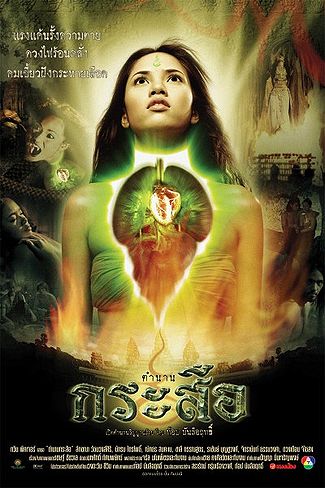
Such problems are especially evident in 2002’s KRASUE (a.k.a. DEMONIC BEAUTY) from Thailand, which even though it’s only the third krasue movie I’ve sat through suffers a pretty severe case of the same-old-shit syndrome. Its set in the distant past, with an adulterous princess sentenced to death. Her soul enters the body of an identical twin living in a nearby village, causing her head and organs to float around each night; in this guise the gal kills several animals and pins the suspicion on a local old lady.
To be fair, there are some memorable scenes, such as a krasue-cobra fight and a gross bit in which the critter sticks its tongue through the bottom of a hut to lap up a newborn baby’s afterbirth. The film also looks good and contains unusually elaborate CGI effects: we actually see the protagonist’s torso split open—in close up—to disgorge the head and innards. That doesn’t mean, though, that the effects are especially convincing, or that KRASUE overall is terribly exciting. It’s talky and repetitive, and ultimately brings very little to this peculiar subgenre.
KRASUE VALENTINE [a.k.a. GHOST OF VALENTINE] from 2006 is another Thai take on the myth, and a far better movie in every respect. It’s set in a mental hospital where an attractive nurse is afflicted with the Krasue curse. It seems she’s the reincarnation of a woman who years earlier was in love with a man who happens to have been reincarnated himself, as a fellow hospital employee. The problem is he’s been paralyzed in an attack, while she can’t seem to keep her head and innards from becoming airborne each night.
KRASUE VALENTINE is about as slick as these movies get, with a canny self-awareness and real horrific flair, as exemplified by a startling dream sequence in which the heroine is shocked to look down and find she has no body. It would be a classic but for some lame would-be comic relief, provided by a couple bungling hospital attendants, and a less-than-satisfying wrap-up. It is, however, one of the very few Krasue flicks to inspire som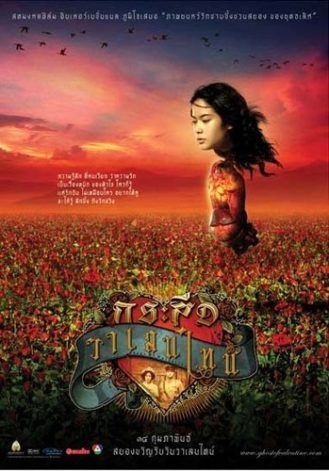 ething other than derisive laughter.
ething other than derisive laughter.
The same year brought yet another Thai production, KRASUE PUN SIEW, which falls at the opposite end of the spectrum quality-wise. It’s probably the single crappiest film on the list, a dreary piece of unalloyed sexploitation with scary bits that appear to be included solely as an excuse to justify the copious sex scenes. Such scenes, BTW, are crappy and unerotic, done with an excess of dissolves and tacky synthesizer muzak. And then there are the effects, easily the worst you’ll see in any Krasue movie: the floating head and organs are accomplished with a mixture of stop motion animation and CGI that manages to pinpoint the worst aspects of both!
But there are some novel twists on the Krasue theme to be found in KRASUE PUN SIEW, such as a blowjob made memorable by the fact that it’s given by the title character (who the recipient somehow doesn’t notice). The story for its part is standard revenge stuff, with a murdered chick, now a Krasue, looking for vengeance on the assholes that gangbanged and killed her. She ends up possessing the body of one of the perpetrator’s girlfriends, and the proceedings grow even more turgid than they were to begin with. For bad movie buffs this is a film of obvious interest, but everyone else should stay far, far away.
Cambodia got into the act with BURN THE WITCH [PLERNG CHES ARB] in 2005. Here we have an old woman living in an impoverished village whose head and innards take the expected nightly stroll. In such a guise she haunts the local swamps, devouring frogs and scaring villagers. The woman’s daughter, meanwhile, is dating a young punk, which makes the village bully jealous. He beats up the punk, inspiring the old goat to zap him with a psychic meteor; this only inflames the other residents of the village, who rise up in mass to justify the title.
BURN THE WITCH is a tacky production, shot on video with the most primitive digital effects imaginable (example: the old woman’s head poorly superimposed atop a mass of hanging organs) and bearing an annoying tendency to veer into slow motion without any apparent rhyme or reason. There’s also the unfortunate fact that according to Cambodian folklore the Arb (as these things are known therein) can’t hurt anyone without a good reason. This means there’s none of the blood drinking, fire breathing or fetus devouring I’ve come to expect from these kinds of films—in other words, none of the fun!
Yet there exists an earlier Cambodian production, 2002’s ARB (a.k.a. VAMPIRE), that takes an altogether different approach. The Arb here is very much in the throat-ripping tradition of MYSTICS IN BALI and KRASUE, and if you ask me the film is all the better for it! Another plus is that ARB, unlike BURN THE WITCH, was shot on film and evidently had a respectable budget.
ARB begins with an Arb-afflicted coot who, after imbibing the afterbirth of a newborn, is waylaid by a pack of scumbags, who also victimize a happy-go-lucky young couple. The coot is killed but the female half of the couple survives to take on the Arb duties herself—and, for good 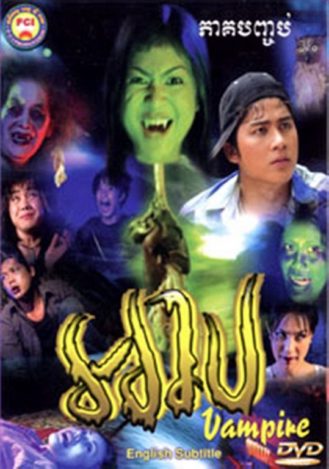 measure, bring the old woman back from the dead.
measure, bring the old woman back from the dead.
In short order the Arb kills off the scumbags and then sets her sights on a group of college pukes vacationing in the area. Far too much screen time is lavished on these twerps and their dopey misadventures, which are on the level of a lowbrow Hollywood teen comedy—and for that matter the film overall, at a full two hours, is way overlong. But the scenes of the Arb doing its dirty work are among the most effective I’ve seen. While the special effects may not be Academy Award caliber, the lighting and camerawork are superb, and the blue-tinted mist that always accompanies the Arb lends an appropriately eerie touch. If only the rest of the film were up to the same standard!
And that, for better or worse, ends my survey of Penanggalan/Krause/Arb movies from South Asia. I could go on about the wonderful, mind-bending insanity of South Asian horror/exploitation movies—notable examples include BLACK MAGIC, THE BOXER’S OMEN, THE KILLING OF SATAN, SEEDING OF A GHOST, LADY TERMINATOR, THE QUEEN OF BLACK MAGIC, GINSENG KING and THE RAPE AFTER—but this piece is specifically about floating head movies, so I’ll leave it at that. Those desiring an introduction to Asian cult cinema will do well to check out any of the cinemutations outlined above; these films won’t ever make anyone’s list of the greatest movies ever made, but they will leave you wanting more.
